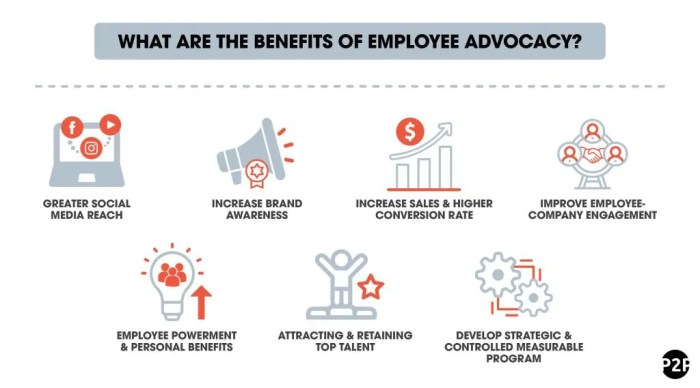Developing an Employee Advocacy Program kicks off the journey towards a more engaged workforce and a stronger brand presence. Imagine a workplace where employees are empowered to share their company’s story and values with the world, creating a ripple effect of positive impact.
As we delve deeper into the key components and steps involved in creating this program, you’ll uncover the secrets to fostering a culture of advocacy within your organization.
Importance of Employee Advocacy Programs

Employee advocacy programs play a crucial role in enhancing a company’s brand image and engaging employees in promoting the organization. By empowering employees to share company content on their personal social media platforms, businesses can reach a wider audience and build credibility. This not only boosts brand awareness but also fosters a positive company culture where employees feel valued and connected to the organization’s mission.
Benefits of Employee Advocacy Programs
- Increased reach and visibility: Employee advocacy expands the company’s reach on social media, allowing for greater exposure to potential customers.
- Enhanced credibility and trust: Customers are more likely to trust recommendations from employees rather than traditional advertising.
- Improved employee engagement: Involving employees in advocacy programs can boost morale and encourage a sense of ownership within the company.
Examples of Successful Companies
- Starbucks: The coffee giant encourages employees to share their experiences on social media, creating a more authentic and relatable brand image.
- Dell: Dell’s employee advocacy program has led to increased social media engagement and a stronger online presence.
- IBM: IBM’s advocacy program has helped employees become brand ambassadors, driving positive word-of-mouth and attracting top talent.
Impact on Brand Awareness and Company Culture
Employee advocacy can significantly impact brand awareness by leveraging the personal connections of employees to reach a broader audience. When employees share company content, they contribute to a positive brand image and help build trust with consumers. Moreover, fostering a culture of advocacy within the organization can strengthen employee morale, improve retention rates, and create a more cohesive and motivated workforce.
Key Components of an Employee Advocacy Program
Employee advocacy programs are crucial for enhancing brand awareness and credibility. To create a successful program, several key components must be considered.
Essential Elements for Success
- Clear Guidelines: Provide employees with clear and concise guidelines on how to participate in the advocacy program.
- Training and Support: Offer training sessions to educate employees on best practices for advocacy and provide ongoing support.
- Incentives: Implement incentives such as rewards or recognition to motivate employees to actively engage in advocacy.
- Monitoring and Measurement: Regularly monitor and measure the impact of the program to identify areas for improvement.
Role of Leadership
- Setting the Tone: Leadership must set a positive example by actively participating in the advocacy program themselves.
- Providing Resources: Leaders should allocate resources and support to ensure the program’s success.
- Encouraging Participation: Leaders should encourage and empower employees to share their experiences and ideas through advocacy.
Alignment with Company Values and Goals
- Integration: Ensure that the advocacy program aligns with the company’s values, mission, and overall goals.
- Consistency: Maintain consistency in messaging to reflect the company’s brand identity and objectives.
- Evaluation: Regularly evaluate the program to ensure it continues to align with the evolving needs and priorities of the company.
Steps to Develop an Employee Advocacy Program: Developing An Employee Advocacy Program

Creating an employee advocacy program involves a strategic process to engage employees, encourage participation, and provide training on social media best practices.
1. Define Objectives and Goals
- Identify the purpose of the advocacy program and what you aim to achieve.
- Set specific, measurable goals to track the success of the program.
- Align objectives with overall marketing and branding strategies.
2. Select Advocates
- Identify enthusiastic and knowledgeable employees who can represent the brand well.
- Ensure diversity in advocates to reach different audiences.
- Provide incentives or recognition to motivate advocates.
3. Develop Guidelines and Training
- Create clear guidelines on what employees can and cannot share on social media.
- Offer training sessions on social media best practices, including security and etiquette.
- Regularly update employees on changes in social media platforms and policies.
4. Provide Resources and Support, Developing an Employee Advocacy Program
- Offer content, images, and updates that employees can easily share.
- Provide tools or platforms for advocates to schedule and track their posts.
- Assign a dedicated person or team to support advocates and answer questions.
Measuring Success and ROI of Employee Advocacy Programs
Employee advocacy programs can be a game-changer for businesses, but how do you know if your program is actually working? Let’s dive into the key metrics to track success and measure the return on investment (ROI) of employee advocacy initiatives.
Key Metrics to Track Success
- Engagement Rate: Monitor how actively employees are participating in sharing content and engaging with posts.
- Reach and Amplification: Measure the increase in brand visibility and reach due to employee advocacy efforts.
- Click-Through Rate (CTR): Track the number of clicks on shared content to gauge interest and effectiveness.
- Lead Generation: Keep tabs on how many leads are being generated through employee-shared content.
Measuring ROI of Employee Advocacy Initiatives
- Cost Savings: Compare the cost of acquiring leads through employee advocacy versus traditional marketing methods.
- Sales Revenue: Analyze the impact of employee advocacy on sales revenue and customer acquisition.
- Customer Lifetime Value (CLV): Determine the long-term value of customers acquired through employee advocacy efforts.
- Brand Sentiment: Measure the shift in brand perception and sentiment among customers and prospects.
Importance of Feedback and Data Analysis
Feedback from employees and data analysis play a crucial role in optimizing an employee advocacy program for better results. By listening to employee input and analyzing performance data, companies can identify areas for improvement, refine their strategies, and ensure the program is driving tangible results.












